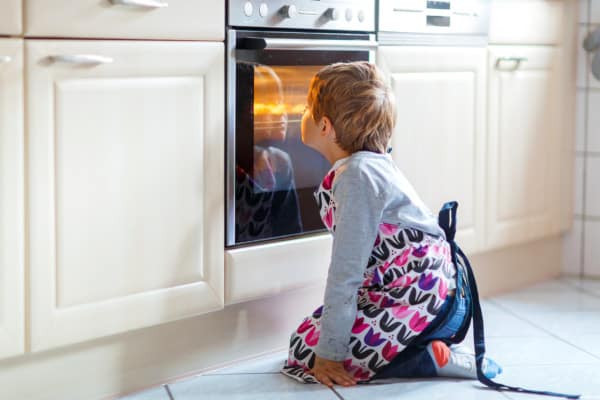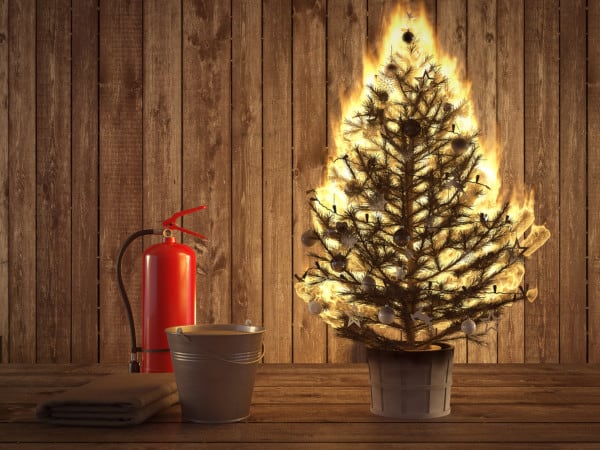Thousands of Americans experience home fires during the holiday season. Learn vital Thanksgiving fire safety tips
Ah, fall. During what poet John Keats called this “season of mists and mellow fruitfulness,” the sun sets earlier, temperatures dip, and we eschew lounging in lawn chairs for cooking, decorating, shopping, and traveling. With Thanksgiving just days away, we are officially in the throes of the holiday season.
Unfortunately, more home fires occur in the United States on Thanksgiving than any other day of the year, according to the National Fire Protection Association (NFPA). But by being aware of and following some Thanksgiving fire safety tips from NFPA, you can safely enjoy a happy holiday.
The high cost of home fires
Residential fires are responsible for more deaths than any other type of fire in the United States. An October 2019 report by NFPA shows that during 2013-2017, 79 percent of all deaths and 73 percent of reported injuries due to fire were caused by home fires. During this period, U.S. fire departments responded to more than 350,000 home structure fires, which caused an annual average of 2,620 civilian (non-firefighter) deaths; 11,220 civilian injuries; and nearly $7 billion in property damage.
Thanksgiving fire safety tips from NFPA: Holiday cooking fire safety is essential
The kitchen is the heart of many homes year-round. It is also where most fires start. The leading cause of home fires and injuries and the second-leading cause of deaths due to a home fire is cooking (smoking is No. 1).
According to the Oct. 19 NFPA report, cooking caused an average of 173,200 reported home structure fires per year (49 percent of all reported home fires in the U.S.) during 2013-2017. These incidents resulted in an average of 550 deaths (22 percent of all home fire deaths) and 5,020 injuries (45 percent of all reported home-fire injuries) annually.
NFPA also reports that danger stems from everyday appliances:
- Ranges or cooktops were involved in 62 percent of reported home cooking fires, 89 percent of cooking fire deaths, and 79 percent of cooking fire injuries.
- Households that use electric ranges have a higher risk of cooking fires and associated losses than those using gas ranges.
- Clothing was the item first ignited in less than 1 percent of fires, but clothing ignitions led to 14 percent of the home cooking fire deaths.
- Almost 30 percent of people killed by cooking fires were sleeping at the time.
- More than half (53 percent) of non-fatal injuries occurred when people tried to control a fire themselves.
And the cooking fire statistics peak on the same day each year: Thanksgiving.
More than three times as many home cooking fires occur on Thanksgiving (Christmas is a close second) than on any other day of the year.
Statistics from the National Fire Incident Reporting System (NFIRS) and NFPA show that between 2014-2016, an estimated 2,400 residential building fires were reported to fire departments in the U.S. on Thanksgiving Day. These incidents caused an estimated five deaths, 25 injuries, and $19 million in property loss.
You wouldn’t be wrong in thinking that the danger of dropping a big bird into hot oil is a big contributor (it is) … but deep-fried turkey is not the primary reason that the numbers are so high vs. the other 364 days of the year. The biggest contributing factor to Thanksgiving cooking fires is … unattended cooking.

Holiday cooking fire safety: Concentration in the kitchen is key
Thanksgiving means getting together with family and friends for a big meal. Kitchens across the country become a gathering place, where the buzz of appliances and babel of cooks join the din of kids running around and adults arguing about politics. Add some alcohol, and it’s easy to become distracted.
Though you may not be able to keep family members from arguing, NFPA has several tips—related to cooking and other fire hazards—for staying safe this season:
- Stay in the kitchen while you are cooking on the stovetop so you can keep an eye on the food.
- Stay in the house while cooking your turkey, and check it frequently.
- Also stay inside while simmering, baking, or roasting food, and use a timer to remind you that you are cooking. Consider putting timers in different rooms so you can hear them over music and party chatter.
- Be on alert! If you are sleepy or have consumed excess alcohol, don’t use the stove or stovetop.
- Keep anything that can catch fire—oven mitts, wooden utensils, food packaging, towels, or curtains—away from the stovetop.
- Keep children at least three feet away from the stove, and make sure kids stay away from hot food and liquids which can cause serious burns. Keep knives, matches, and utility lighters out of the reach of children, and make sure electrical cords from appliances are not dangling off the counter within easy reach of a child. Never leave kids alone in a room with a lit candle.
- Keep the floor clear of toys, bags, etc., to avoid tripping.
In addition to staying alert and aware while preparing a Thanksgiving feast, you should add another layer of safety by having a fire extinguisher near the kitchen. In addition, fire blankets are also particularly effective at containing small cooking fires.
Do you need a fire extinguisher? Click here to view our online selection. To order Class K extinguishers that are effective against grease fires or to get fire blankets, call us at +1 (888) 361-6662 or email support@qrfs.com.
Make sure your extinguishers and smoke alarms are in good working order. And If you don’t already have one, a carbon monoxide (CO) alarm is an important piece of safety equipment, especially this time of year. The Centers for Disease Control and Prevention (CDC) report that around 50,000 people in the U.S. visit emergency rooms and more than 400 die after accidental CO poisoning each year.
Colder weather means more heating sources are used more often, and CO is found in “fumes produced by furnaces, kerosene heaters, vehicles ‘warmed up’ in garages, stoves, lanterns, gas ranges, portable generators, and burning charcoal and wood. CO from these sources can build up in enclosed or partially enclosed spaces.”
Deep-fried turkey fire safety
If you plan to deep fry a turkey, mind these tips from the Federal Emergency Management Agency (FEMA) and the U.S. Fire Administration:
- “Use your turkey fryer only outdoors on a sturdy, level surface well away from things that can burn,” since fryers can tip over and spill hot oil.
- Prevent burn injuries by having a “3-foot kid- and pet-free zone” surrounding the fryer.
- Do not overfill the fryer with oil; initially place the turkey in a pot filled with water to gauge the right amount of oil to use.
- Completely thaw the turkey before frying it. Partially frozen birds will make the oil pop and splatter.
- Routinely assess the temperature with a cooking thermometer to prevent oil from overheating and catching fire.
- Always protect your hands and forearms with gloves; the lid, pot, and handles will get extremely hot.
In addition, make sure the fryer is not placed near combustible materials, such as the wall of your home. Why? Well, watch what can happen when a frying a turkey goes wrong:
Have an emergency action plan
If you take precautions this holiday season, the only fires you may have to put out will be those family political arguments. But because accidents happen, here are some NFPA tips in the event that a small cooking fire does break out:
- If it’s in a pan on the stovetop, smother the flames by sliding a lid over the pan. Turn off the burner and leave the pan covered until it is completely cooled.
- If it’s an oven fire, turn off the heat and keep the door closed.
- Most importantly, if you have any doubts about fighting a small fire, get everyone out of the house. Close the door behind you to help contain the fire, and then call 9-1-1.
Again, awareness is the most important ingredient in any holiday meal preparation.
“Thanksgiving is a festive but hectic holiday, where people are often preparing several dishes at once,” says Lorraine Carli, vice president of Outreach and Advocacy at NFPA. “They’re also entertaining friends and family with lots of other potential distractions. Knowing where potential cooking hazards exist and taking basic precautions to prevent them can go a long way toward ensuring a fire-safe holiday.”

Don’t forget about other holiday home fire risks
Fire risks don’t end once the turkey leftovers are gone from the fridge. The twinkling lights strung on Christmas trees and hung on houses can be as perilous as they are pretty. Trees and lighting equipment have been found to contribute to or cause many residential fires during the Christmas holiday, often in January, as dying trees dry out.
The Oct. 2019 NFPA report shows that between 2013-2017, U.S. fire departments responded to an average of 160 home fires that started with Christmas trees per year. These fires caused an average of three deaths, 15 injuries, and $10 million in direct property damage annually, and one of every 52 reported home fires that began with a Christmas tree resulted in a fatality.
Get a jump on a safe season by reading these NFPA Christmas Tree Safety tips.
Candles which are another popular element in holiday decorations can also be a fire hazard. NFPA reports that during 2012-2016, U.S. fire departments responded each year to around 8,200 home fires started by candles. Annually, the fires caused an average of 80 deaths, 770 injuries, and $264 million in direct property damage. In addition to keeping candles away from decorations and other flammable materials—and never leaving them unattended—NFPA has a list of other Winter Holiday Safety tips.
Remember that neither bad wiring nor candles are the main source of home fires during the holidays—cooking remains the primary culprit.
So, stay safe. And keep a close eye on that turkey.
QRFS is dedicated to fire safety. If you need fire extinguishers, residential fire sprinklers, or other equipment that protects lives and property from fire, check out our online selection.
Class K fire extinguishers and fire blankets are available via special order. Call us at +1 (888) 361-6661 or email support@qrfs.com.
This blog was originally posted at blog.qrfs.com. If this article helped you, check us out at Facebook.com/QuickResponseFireSupply or on Twitter @QuickResponseFS.


